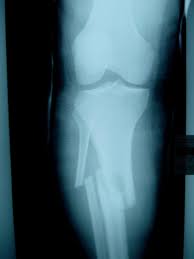 Scientists fix fractures with 3D-printed synthetic bone (MassDevice)
Scientists fix fractures with 3D-printed synthetic bone (MassDevice)
Scientists in the United States have successfully treated broken spines and skulls in animals using 3D-printed synthetic bone, opening the possibility of future personalized bone implants for humans to fix dental, spinal other bone injuries.
Unlike real bone grafts, the synthetic material – called hyper-elastic bone – is able to regenerate bone without the need for added growth factors, is flexible and strong, and can be easily and rapidly deployed in the operating room.
Giving details in a teleconference, the scientists said the results of their animal trials – published on Wednesday in the Science Translational Medicine journal – were “quite astounding”.
Human trials could begin with five years, they said.
The team found that when used in spinal injuries in rodents and to mend the skull of a monkey, the hyper-elastic bone, made mostly of a ceramic and polymer, quickly integrated with surrounding tissue and began regenerating bone.
It swiftly mended bones in the spines of the rats and healed the monkey’s skull in just four weeks, with no signs of infection or other side effects, the scientists said.
“Another unique property … is that it’s highly porous and absorbent – and this is important for cell and tissue integration,” said Ramille Shah of Northwestern University’s department of material science, engineering and surgery, who co-led the work.
“Even when it’s deformed or squeezed into a space, it still maintains high porosity, and this is also very important for blood vessels to infiltrate the scaffold so that it can further support cell and tissue growth.”
Other types of bone grafts currently in development are often too brittle to be shaped and handled by surgeons, and risk being rejected once inside the body, or may be too expensive or difficult to manufacture for widespread use.
With this hyper-elastic bone, however, many of those issues would be overcome, said Adam Jakus, Shah’s co-researcher at Northwestern University.
“It’s purely synthetic, very cheap and very easy to make,” he said. “It can be packaged, shipped and stored very nicely.”
Shah she hoped these properties would mean patients in developing countries would also benefit.
“There are a lot of paediatric patients, especially in third world countries, who are born with orthopaedic or Maxillofacial(face and jaw bone) defects,” she said. “And because the hyper-elastic bone is scalable at a low cost, (we hope) it would be accessible to those types of patients.”
Giving details in a teleconference, the scientists said the results of their animal trials – published on Wednesday in the Science Translational Medicine journal – were “quite astounding”.
Human trials could begin with five years, they said.
The team found that when used in spinal injuries in rodents and to mend the skull of a monkey, the hyper-elastic bone, made mostly of a ceramic and polymer, quickly integrated with surrounding tissue and began regenerating bone.
It swiftly mended bones in the spines of the rats and healed the monkey’s skull in just four weeks, with no signs of infection or other side effects, the scientists said.
“Another unique property … is that it’s highly porous and absorbent – and this is important for cell and tissue integration,” said Ramille Shah of Northwestern University’s department of material science, engineering and surgery, who co-led the work.
“Even when it’s deformed or squeezed into a space, it still maintains high porosity, and this is also very important for blood vessels to infiltrate the scaffold so that it can further support cell and tissue growth.”
Other types of bone grafts currently in development are often too brittle to be shaped and handled by surgeons, and risk being rejected once inside the body, or may be too expensive or difficult to manufacture for widespread use.
With this hyper-elastic bone, however, many of those issues would be overcome, said Adam Jakus, Shah’s co-researcher at Northwestern University.
“It’s purely synthetic, very cheap and very easy to make,” he said. “It can be packaged, shipped and stored very nicely.”
Shah she hoped these properties would mean patients in developing countries would also benefit.
“There are a lot of paediatric patients, especially in third world countries, who are born with orthopaedic or Maxillofacial(face and jaw bone) defects,” she said. “And because the hyper-elastic bone is scalable at a low cost, (we hope) it would be accessible to those types of patients.”